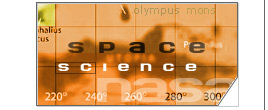What does the public understand about astronomical concepts? How can visitor studies done at museums and planetariums help inform future programs and exhibits? What are the "best practice" examples of successfully involving space scientists in informal education projects? This area of Space Science Access is dedicated to helping scientists and informal educators apply the results of experience and education research to improving future space science education experiences for all audiences. |
 |
|
|
|
| How Do Museum Visitors Understand the Universe | |
| This article, which was published in the May/June 1999 Association of Science-Technology Centers Newsletter, presents an overview of several front-end visitor studies. | |
| Astronomy Education Review | |
| This site from the National Optical Astronomy Observatory makes it easy to find, read about, and use new ideas and resources for teaching and outreach in astronomy and space sciences. | |
| ASTC: Profiles of Scientists | |
| The Association of Science-Technology Centers has created a set of "behind-the-scenes" profiles of the people involved in museum exhibits and programming. Check out the variety of ways space scientists have been involved. | |
| Scientists in Education: Roles Matrix | |
| This document highlights the variety of roles scientists can play within educational institutions, from advocate to full partner. | |
| Informal Education Survey by NASA Earth Sciences | |
| In 1999 NASA Earth Science Enterprise conducted a survey of informal science education institutions regarding ideas for collaboration. See the results here. | |
| Recommendations from Great Lakes Planetarians | |
| Gary Sampson, a member of the Great Lakes Planetarium Association, made these recommendations for ways that the NASA Space Science community could work with planetarians. | |

:: This site serves NASA's Office of Space Science (OSS) Education and Public Outreach Support Network ::
